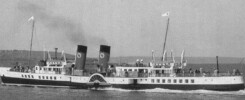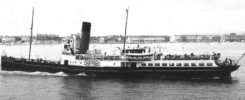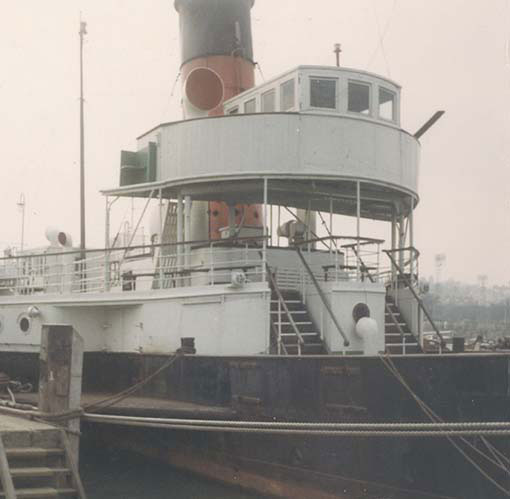
Fifty years ago, 1965 was a landmark year for paddle steamers with a Weymouth connection.
It was the last year in which a paddle steamer was based at Weymouth with the Princess Elizabeth (pictured above in the Weymouth Backwater), which had taken over the service from Cosens’s Consul in 1963, operating excursions along the Dorset Coast throughout the season.
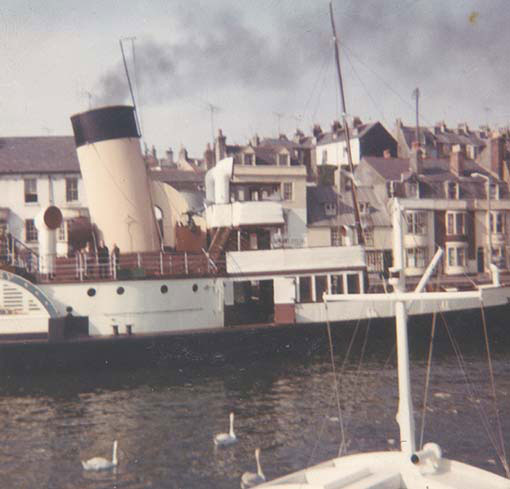
It was the last year in which the paddle steamer Embassy (pictured above alongside Trinity Wharf, Weymouth) made an advertised public sailing from Weymouth.
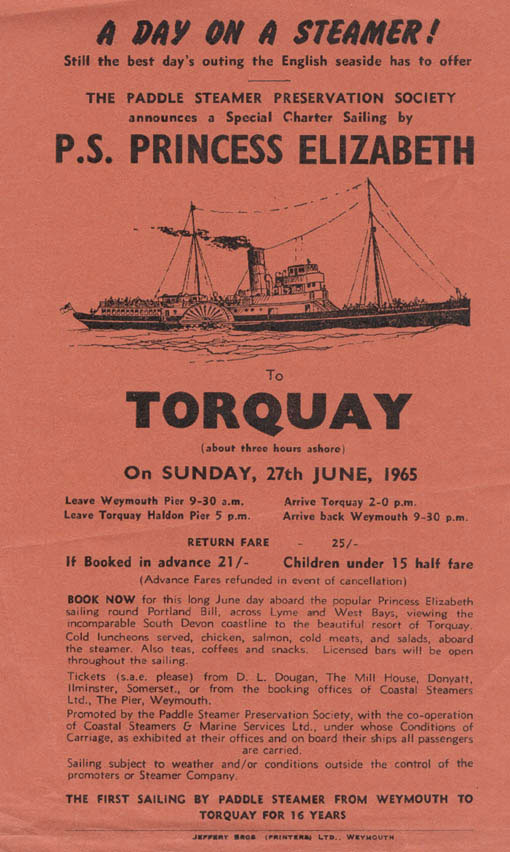
It was a year in which the PSPS ambitiously chartered both the Embassy and the Princess Elizabeth for excursions which had not been run for many years: a day trip from Weymouth round the Isle of Wight on the Embassy on Saturday 5th June and a day trip from Weymouth to Torquay on the Princess Elizabeth on Sunday 27th June. Unfortunately neither ended up with good passenger loads, the Embassy picking up less than 50 at Weymouth on her charter.
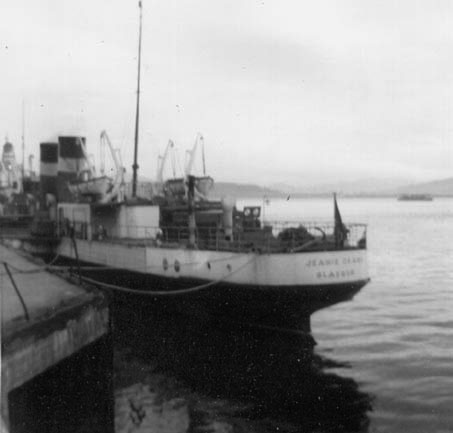
It was the year in which Weymouth based shipbroker Tony McGinnity, who had just sold the Consul, persuaded Don Rose to buy the Clyde paddle steamer Jeanie Deans for a new future running on the Thames. It was the Princess Elizabeth’s Captain Woods who went up to the Clyde with some of his Weymouth crew to take her round to the Medway that November.
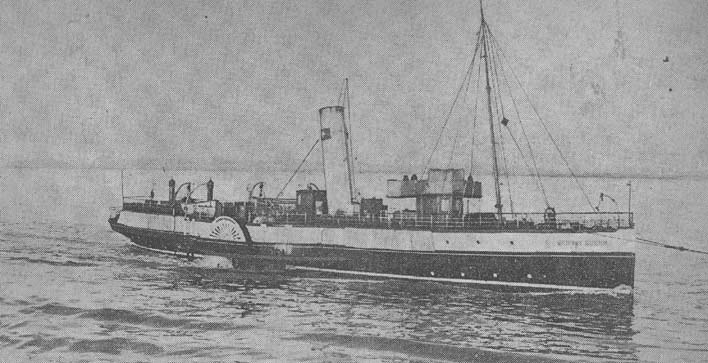
It was the year in which, with various nudges from the same Weymouth shipbroker office, the paddle steamer Medway Queen was towed from the Thames for a new life as a restaurant and bar at Binfield on the Isle of Wight.
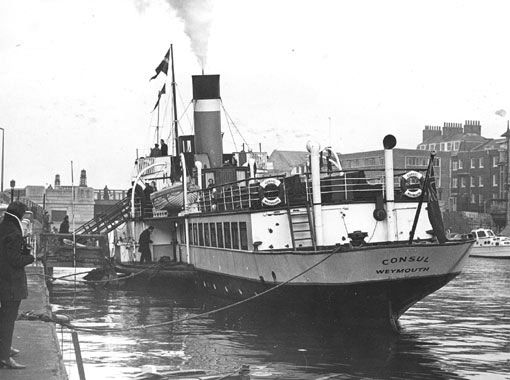
It was also the year in which the Consul sailed away from Weymouth, never to return.
Here she is alongside Trinity Wharf getting ready for that last sailing on 4th February with former Cosens’s Captain Harry Defrates on the port bridge wing next to the much taller Tony McGinnity. Fred Miller was the mate and Bob Wills, a former chief engineer, presided over the engine room. Also aboard was my school friend Richard Clammer. We were both fourteen that year but were already seasoned paddle steamer lovers and PSPS members with an interest extending way back into our earliest years in the mid 1950s although we didn’t actually meet until we both fetched up at Weymouth Grammar School in 1962.
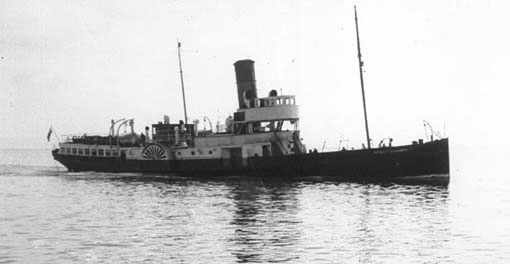
Having spent the 1964/65 winter in Weymouth, the Princess Elizabeth (pictured above off Weymouth) steamed off to Husband’s Yard at Southampton after Easter for her annual slipping and was due back in the late afternoon of Friday 4th June, the day before the Embassy’s PSPS charter round the Isle of Wight.
As usual whenever I knew that a paddle steamer event was about to happen I went down to the harbour to check it out. The day had been lovely but fog had been in the air as the afternoon wore on and finally down it had come enveloping everything. The harbour and bay were covered. Nothing could be seen although it was clear that the Princess Elizabeth was not far off from the sound of her whistle as she groped her way homewards.
There was some discussion on the pier that the Embassy was sitting in the Lizzie’s berth ready for her one and only passenger trip from Weymouth that season the following morning and that the Lizzie would not expect her to be there so might, in the fog, run into her. To help avert this an oil lamp had been rigged on the rails at the aft end of the Embassy’s promenade deck to highlight her presence. Note it was an oil lamp. Although the Embassy did have a steam generator and was fitted with electric lights, these only worked when the generator was running and the generator was turned off at night. Keeping it going would have needed a man to tend it costing money so, ever parsimonious, that was a step too far for Cosens.
At last, guided by the ringing of the Pleasure Pier bell, the Princess Elizabeth, under the command of Capt Stanley Woods, a long standing friend of Mrs Eileen Pritchard PSPS member number 1, slowly loomed out of the mist at about 7.30pm, missed the Embassy, just, and, after some difficulty getting the ropes ashore, berthed ahead of her.
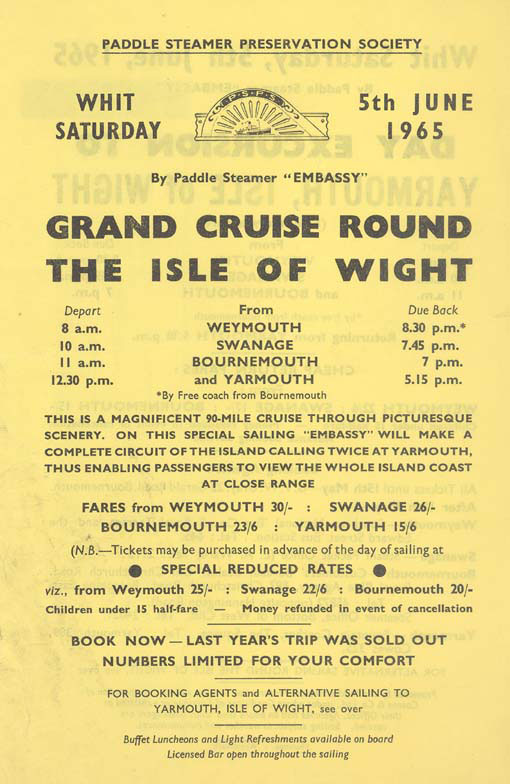
The following morning I was back on the pier again, this time with Dad, for the Embassy’s scheduled 8am departure for her PSPS charter round the Isle of Wight. We wondered if she would go as the thick fog from yesterday was still engulfing everything. Indeed, the Channel Island mail-boat Caesarea and the chartered Channel Island cargo boat Lune Fisher, both due into Weymouth in the early hours, had thought discretion the better part of valour and were prudently anchored in the offing awaiting better visibility.
Deciding whether or not to sail in inclement weather is a difficult call for any master particularly in fog for a steamer without any of the modern forms of electronic navigation or radar. An announcement was made at sailing time that we would wait a bit and see if the fog improved.
After about half an hour the fog was still pretty dense but Capt Iliffe decided to sail perhaps calculating that fog often burns off early on a sunny day and that the first part of the trip was, in any case, straightforward across what was likely to be a pretty empty Weymouth Bay. At 8.25am the telegraph rang “stand by”. We backed out, turned eastwards and paddled off passing close to the fog shrouded silhouettes of the anchored Caesarea and Lune Fisher both vigorously ringing their anchor bells.
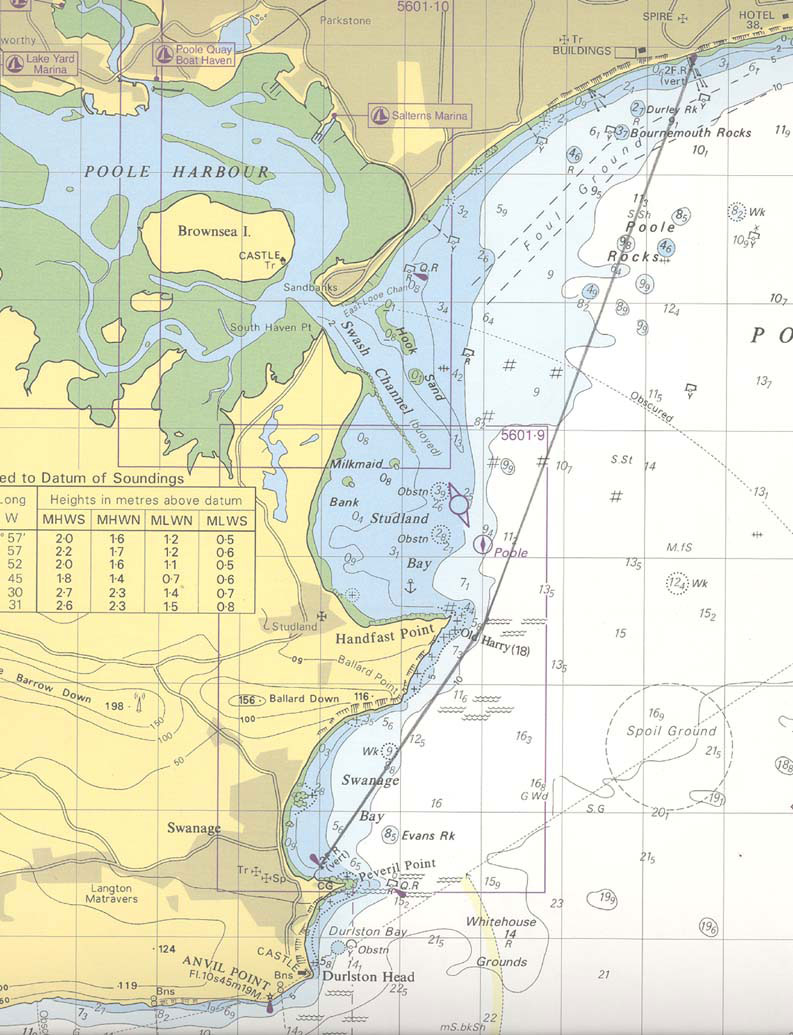
As we crossed the bay the visibility did improve but by St Albans Head dense fog was back and we saw nothing of Anvil Point, Durlston Head or Peveril Point before Capt Iliffe, judging the distance run, turned westwards towards Swanage Pier. Speed was reduced. Ears were sharpened and the distant ringing of the Swanage Pier bell was heard and gradually grew louder until the pier itself, bathed in weak sunshine, emerged ahead from the fog.
More passengers boarded and the Embassy left at 11.05am, about one hour behind schedule. Immediately we ran into thick fog again. As you can see from the mini chart above, the course from Swanage to Bournemouth is not a straight line. You have to steer out north eastwards before making a slight alteration, a few degrees towards the north, after Handfast point and the Old Harry Rocks for Bournemouth.
About 10 minutes out from Swanage the engine room telegraph rang. I was always interested to know what instructions the captain was giving so, as usual, made off to the engine room to have a look. When I got there the telegraph was set on “full astern” with Chief Engineer Alf Pover at the levers. After a while it went to “stop” and then “full ahead” and we were off again.
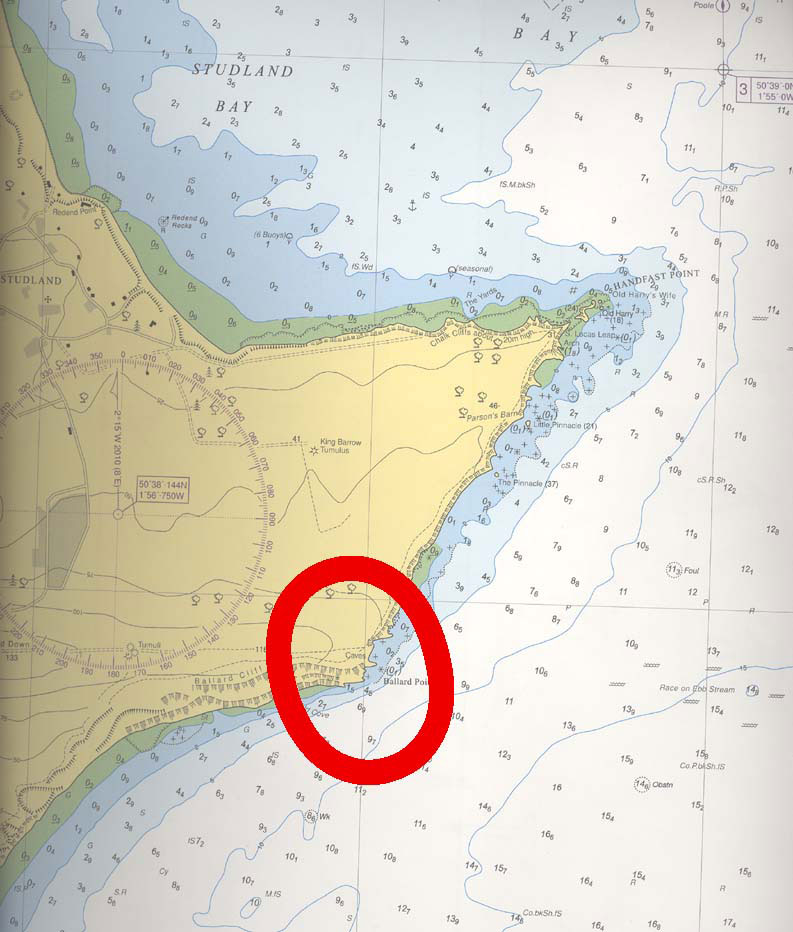
My first thought was that we must have seen a yacht. Emergency stops for yachts were not exactly commonplace but they did happen and I had seen them before.
Then Dad came down and told me that we had nearly run into Ballard Point. There is a picture of this event in Richard Clammer’s Cosens of Weymouth 1918 – 1996 (do buy a copy if you haven’t got one – it’s tip top) which shows just how close the Embassy came to disaster that morning.
If an unusually tall man with above average length of arm had been standing on deck holding a long broomstick in his outstretched hands, he could have poked the cliff with it. That’s how close we were.
As always in these circumstances it is difficult to know for sure what went wrong. Perhaps the course was not properly drawn although that is unlikely as this was an habitual route. Perhaps, in the mists, Capt Iliffe mis-judged the starting point from Swanage, maybe thinking that he was further east than he was. Perhaps the tide was stronger than predicted that day pushing the Embassy to the westwards towards the cliffs. Maybe the compass was in error. Compasses not only need properly adjusting annually but should be checked on a daily basis against known headings. And this was the Embassy’s first trip of the season so there had not been an opportunity for that sort of routine check with the fog.
Fortunately, whatever the reason, we had not hit the cliff, no harm had been done so we continued to Bournemouth. There Capt Iliffe, perhaps counting his chickens and taking several deep breaths, announced that we would remain alongside and see if the fog cleared.
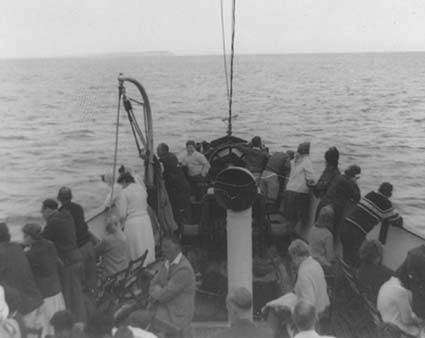
By 12.30pm visibility had greatly improved so a decision was taken to sail and off we went again. In the picture above looking down onto the Embassy’s foredeck you can just make out the Isle of Wight with the Needles fine on the port bow in the distance. The adolescent in the cream anorak in the bow on the port side is me.
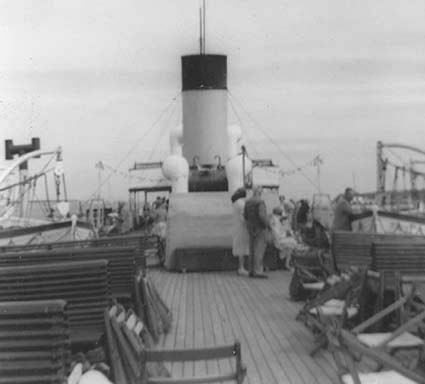
Yarmouth was reached at 2pm, an hour and a half late, and Embassy set off again back down the Needles Channel and round the Island anti-clockwise. The malevolent fog had not given up entirely and, after the first part of Freshwater Bay, it set in again although it was nowhere near as thick as earlier. Capt Iliffe prudently stood well out and nothing was seen of the southern tip of the Island or St Catherine’s point until we were well on into Sandown Bay.
In all my childhood years, including visits to various paddle steamer bridges, I had never previously seen a captain use a chart. They had the charts all memorised, all the courses, distances, hazards and tides were all in their heads. But on this difficult fog laden day I did see Capt Iliffe and the mate Eric Plater fishing out and studying the charts with parallel rule, dividers, pencil and rubber at the ready.
Having passed through the Solent, the Embassy reached Yarmouth again at 7pm and Bournemouth at 8.35pm, about an hour and a half late, where Dad and I disembarked to take the coach back home to Weymouth.
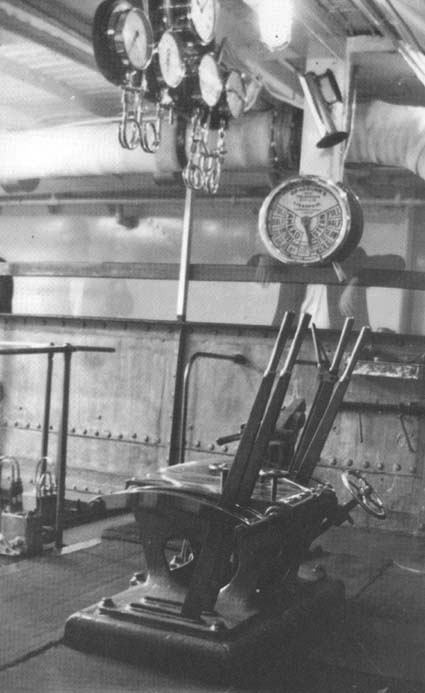
To my 14 year old eyes, the Embassy’s close encounter with Ballard Point didn’t seem very much of a big deal at the time. OK she had come a bit close but she hadn’t hit it, had she?
Now half a century later I wonder just how lucky we were that day. If the cliffs had not been so steep to at that point; if they had been spotted a second or two later; if Captain Iliffe had not been so quick on the telegraph; and, above all, if Chief Engineer Alf Pover had not handled his levers so adroitly putting the engine into such a prompt “full astern” then the day might have panned out quite differently and the Embassy might have gained a different place in history alongside…
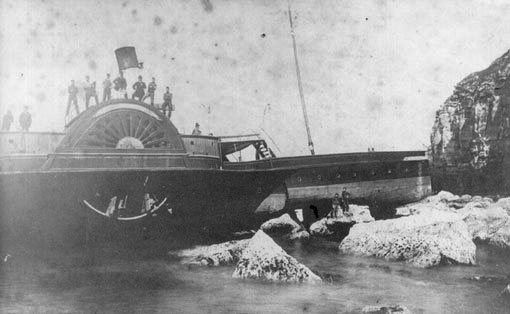
…the paddle steamer Bournemouth which ploughed into the cliff on the west side of Portland in similar circumstances on a calm day in thick fog on the return leg of a day trip from Bournemouth to Torquay in the early evening of Friday 27th August 1886.
John Jones from Australia wrote:
John, just to say how much I enjoy your monthly pieces and June was particularly evocative. I grew up with the North Wales steamers which were not quite the same thing but your article still resurrected lots of nostalgic thoughts – trips with Dad etc. The vessels certainly seemed to sail in weather that would be unacceptable today. I remember several times being unable to land at Llandudno and going straight on to Menai Bridge. The trip back in the evening, meeting the Manx boat racing in from the Bar Light and what then seemed huge liners (tiny now!) departing – the Cunard Canadian liners of the mid 50s and the Canadian Pacific Empresses come particularly to mind.
I first sailed on Waverley when she visited the Thames in 1978 and have travelled on her regularly since when visiting UK, the last time on the Clyde in 2014. I have been a member of PSPS for about the same length of time.
More power to your pen in the future!
Kingswear Castle returned to service in 2023 after the first part of a major rebuild which is designed to set her up for the next 25 years running on the River Dart. The Paddle Steamer Kingswear Castle Trust is now fund raising for the second phase of the rebuild. You can read more about the rebuilds and how you can help if you can here.
John Megoran

